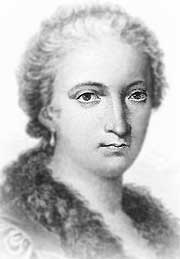Women in Science Series Contest 1 - Mary Gaetana Agnesi (1718- 1799)
First of all, I would like to thank @jasonbu for this magnificent competition, which allows us to investigate history and learn that throughout the history of humanity there have been pioneering women in the field of science, who although they were not duly recognized at the time, nevertheless left a very important legacy. May this humble contribution serve to pay them a well-deserved tribute.
Mary Gaetana Agnesi (1718- 1799)
This Italian mathematician, linguist and philosopher, was born in Milan on 16 May 1718 and the different sources consulted indicate that she learned French, Latin, Greek and Hebrew from a very early age and at the young age of nine wrote a speech defending the right of women to education.
When he was 20 years old, he devoted himself entirely to studying mathematics and religion and in 1748 his most famous work was published: "Instituzioni analítiche ad uso della gioventú italiana", being herself the editor, whose first volume was dedicated to finite magnitudes (algebra and analytical geometry) and the second to infinitesimal analysis (differential and integral calculus), including many examples and figures that made it very didactic.
In this work of approximately 1000 pages, Agnesi managed to present the concepts in a clear way and presented in a coherent and harmonious way the work carried out by other mathematicians of the time. His work represented the first full text of calculus, containing everything from algebra to differential equations, claiming to be the first book to deal with differential and integral calculus together.
One of the examples presented in her work gave Maria G. Agnesi an important place among the manuals of mathematical formulae and tables, the same is known as"The Witch of Agnesi". The sources consulted point out that this name is a mistranslation, as she worked on her book with the Agnesi curve or sinusoidal curve versa or "versiera" in Italian, which means to turn or turn, but the translator John Colson translated it wrongly into English as "Witch of Agnesi".
Below is the method of construction of your curve:
"The construction method is simple; to obtain any point of the curve:
Circle, with center at point (0, a/2)
From the origin, (0, 0), treat straight lines crossing the line y=a (straight line OA in the figure, where a=10)
The point P of the witch is the point at which the lines BP (horizontal passing through the cut between OA and the circumference) and AP (vertical passing through the cut between OA and the line y=a) cross.
The set of the OA lines of the plane determines that of the points of the Agnesi curve." Source
For the history of mathematics Agnesi is important for its influence on the dissemination of calculus. He is also one of the characters most frequently cited in the reflections on the historical role of women in mathematics.
Maria Gaetana Agnesi dedicated 20 of her 81 years of life to mathematics, having a great influence in this important field of knowledge and representing a great example for posterity. She dedicated the rest of her life to charity and the care of the poor, becoming the director of a hospice in which she died on January 9, 1799.
Honor to whom honor is due
Source: Own elaboration



Excellent content! Congratulations! How many valuable women in the history of science!
realmente es una gran historia, las mujeres protagonistas en todos los ámbitos, mucha suerte
Congratulations @lauraac! You have completed some achievement on Steemit and have been rewarded with new badge(s) :
Click on any badge to view your own Board of Honor on SteemitBoard.
To support your work, I also upvoted your post!
For more information about SteemitBoard, click here
If you no longer want to receive notifications, reply to this comment with the word
STOPThank you very much!